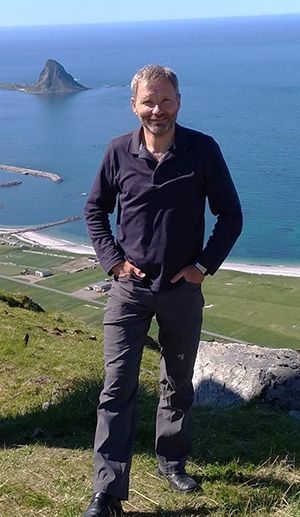
Bart Geerts says the Arctic is arguably the region on Earth that is warming the most rapidly, with rapid sea ice loss and warming air temperatures reinforcing each other. Decreasing ice cover implies potentially more hazardous Arctic winter weather effects upon coastal communities and local transportation.
To better tackle this issue, the University of Wyoming department head and professor of atmospheric science is looking at cold-air outbreaks, which are poorly understood, he says.
“A key question is how the high-latitude changes connect to those in the midlatitude and the global climate system. Outbreaks of cold, Arctic air streaming over open ocean water encourage strong surface fluxes of moisture and heat, supporting shallow, but highly convective clouds,” Geerts says. “These occasionally spawn intense ‘polar lows,’ and both are difficult to forecast. Cold-air outbreaks have a significant impact on the global energy and water cycles, including the ocean circulation.”
To help continue his research, Geerts recently received a U.S. Department of Energy (DOE) grant worth $724,331 over three years. His project is one of 31 in the atmospheric sciences that received $19 million in total funding from the DOE. The projects aim to improve the power of Earth system models to predict weather and climate.
This newest grant builds on a current DOE grant under its Atmospheric System Research (ASR) program, called “Mixed-Phase Convective Clouds in the Polar Marine Boundary Layer.” Under that program, Geerts says observations and modeling are used to focus on the cloud and precipitation properties of shallow convective clouds’ cold air over open waters near the Arctic.
“Despite the impacts on weather and climate, cold-air outbreaks remain difficult to model. This is, in part, because of the range of scales involved, with this cloud regime occupying a ‘gray zone’ where typical weather or climate models fail to capture or parameterize the relevant cloud and dynamical processes,” Geerts explains. “In addition, little is known about the cloud properties; their rain and snowfall amounts; the accompanying boundary layer structure and circulations; interactions with meteorology; and surface fluxes. Very little is known about these clouds, given the emptiness of the Arctic.”
DOE supported a dedicated field campaign -- called Cold-Air Outbreaks in the Marine Boundary Layer Experiment (COMBLE) -- through which the necessary measurements were gathered to support modeling improvements of this mysterious cloud regime.
Geerts served as COMBLE’s lead scientist during the project -- which took place from Dec. 1, 2019-May 31, 2020 -- with DOE’s ASR and 20 international collaborators. Geerts says the campaign’s outdoor laboratory was a vast stretch of open water in the open sea. Their main observation station “was as far north as we could go in Scandinavia,” he says.
“We are using the COMBLE observations to assess multiscale numerical simulations of these clouds and, in turn, we’ll use these simulations to better understand the cloud regime and enable better representation of these clouds in climate models,” Geerts says.
This work is in collaboration with the National Center for Atmospheric Research (NCAR) scientists, and will require a large supercomputer allocation from the NCAR Wyoming Supercomputing Center.
Geerts says the latest DOE grant will fund one Ph.D. student, Christian Lackner, of Mainz, Germany, who will start his studies at UW this fall.
The DOE projects were chosen by competitive peer review under a DOE funding opportunity announcement, which falls under the ASR program and is sponsored by the Biological and Environmental Research program within the DOE’s Office of Science. Selected projects cover a range of atmospheric science topics, including interactions between clouds and aerosols; atmospheric processes in the high northern and southern latitudes; and the development of new data products to render atmospheric data more accessible to researchers.
“Atmospheric processes leading to cloud formation and precipitation are notoriously complex and difficult to model accurately,” says Chris Fall, director of the DOE’s Office of Science. “These studies, which combine observation and modeling, will be important steps toward more precise and predictive models on both regional and global scales.”

